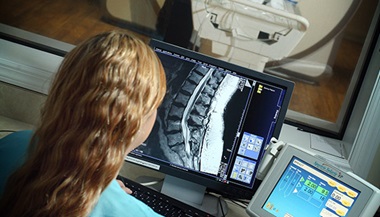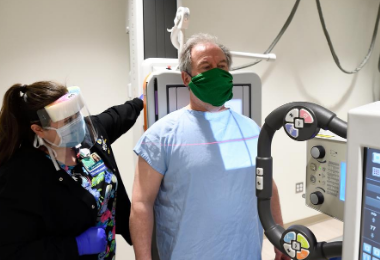Magnetic Resonance Angiography (MRA)
What is magnetic resonance angiography?
You’ve probably heard about the test called magnetic resonance imaging or MRI. In this test, radio waves, a magnetic field, and a computer create a scan of your body parts to look for health problems.
Magnetic resonance angiography–also called a magnetic resonance angiogram or MRA–is a type of MRI that looks specifically at the body’s blood vessels. Unlike a traditional angiogram, which requires inserting a catheter into the body, magnetic resonance angiography is a far less invasive and less painful test.
During magnetic resonance angiography, you lie flat inside the magnetic resonance imaging scanner. This is a large, tunnel-like tube. In some cases, a special dye, known as contrast, may be added to your bloodstream to make your blood vessels easier to see. When needed, the contrast is given with an intravenous (IV) needle.
Why might I need magnetic resonance angiography?
If your healthcare provider believes that you may have a narrowing or blockage of blood vessels somewhere in your body, he or she may recommend magnetic resonance angiography. Other conditions that your healthcare provider can look for during this test include:
An aneurysm or weakness in the wall of an artery
A narrowing of the aorta, or aortic coarctation
Bleeding in and along the wall of the aorta, or aortic dissection
To find the cause of a stroke
Signs of heart disease
Narrowing or blockage of the vessels in the arms or legs
Renal artery stenosis, a narrowing of the blood vessels in the kidneys that can lead to high blood pressure and even renal failure
What are the risks of magnetic resonance angiography?
If a dye is needed to make the blood vessels easier to see during the test, you may experience a bit of discomfort because of the insertion of the IV.
You might also experience some anxiety when placed inside the MRI scanner, which is a small, narrow space. If you think you might be claustrophobic, be sure to inform your healthcare provider of this in advance. You may be given a mild sedative to make being in the MRI scanner more bearable.
Some potential risks of magnetic resonance angiography include:
You may suffer bodily harm from having metal objects in pockets or clothing or metal implants (such as a pacemaker or bullet fragment) within your body. Before you undergo the test, you will be asked a series of detailed questions about any metal you may have in your body.
If you have a problem with your kidneys, you are at risk of developing a severe reaction after receiving the MRI contrast dye that is used to make blood vessels more visible. This reaction can affect tissues throughout the entire the body including the skin, joints, liver, and lungs. If you have a history of kidney disease, your healthcare provider may decide that an MRI or MRA is not for you.
Pregnant women may have additional risks in the MRI scanner. Make sure to tell your healthcare provider if you are or might be pregnant.
You may be at risk for other complications, depending on your specific medical condition. Be sure to discuss any concerns with your healthcare provider before the test.
How do I prepare for an MRA study?
EAT/DRINK: You may eat, drink and take medications as usual.
CLOTHING: You must completely change into a patient gown and lock up all personal belongings. A gown and locker will be provided for you. Please remove all piercings and leave all jewelry and valuables at home.
WHAT TO EXPECT: Imaging takes place inside of a large tube-like structure, open on both ends. You must lie perfectly still for quality images. The machine is very loud, so earplugs are required and will be provided to you.
CONTRAST: Your exam may include an injection of a contrast agent. A contrast agent is a special liquid that is injected through an intravenous (IV) line, a small tube placed in a vein. Some people may notice discomfort, tingling or warmth in the lips, metallic taste in the mouth, tingling in the arm, nausea or headache. These symptoms go away quickly.
ALLERGY: If you've had an allergic reaction to contrast that required medical treatment, contact your ordering physician to obtain the recommended prescription to take by mouth 24, 12 and two hours prior to the exam.
ANXIETY: If you require anti-anxiety medication due to claustrophobia, contact your ordering physician for a prescription. Please note, you will need someone to drive you home.
STRONG MAGNETIC ENVIRONMENT: If you have metal within your body that was not disclosed prior to your appointment, your study may be delayed, rescheduled or cancelled upon your arrival until further information can be obtained.
Your doctor may suggest additional preparation depending on your particular situation.
What happens during magnetic resonance angiography?
Magnetic resonance angiography may be done on an outpatient basis or during a hospital stay. Generally, magnetic resonance angiography follows this process:
You will remove any clothing, jewelry, or other objects that may interfere with the scan and put on a gown.
If you need a contrast dye to make blood vessels easier to see, this will be given through an IV.
You will be positioned on an exam table directly outside the MRI scanner.
The table will slide into position, placing you inside the MRI scanner.
You will need to lie still during the scanning process. Any movements can blur the images and cause the results to be less accurate.
The MRI scanner typically makes a lot of noise, including loud humming noises, so don’t be alarmed.
The full scan may take an hour or longer. This will depend on the type and number of blood vessels that your healthcare provider wishes to examine.
The scan typically causes no side effects or complications. If it is done on an outpatient basis, you are generally free to leave after the magnetic resonance angiography. Your healthcare provider will likely schedule a follow-up appointment to review the results of the test.
What happens after magnetic resonance angiography?
Your healthcare provider will examine the images from the magnetic resonance angiography. If no blockages or irregularities are found, you have what’s called a normal test result. An abnormal result means that the healthcare provider noted an abnormality in one or more of the blood vessels in your body. This may suggest that you have hardening of the arteries, known as atherosclerosis, or another circulatory problem. Your healthcare provider will likely suggest additional tests or treatments based on the specific problem that is discovered.





